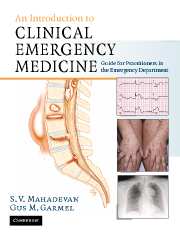Book contents
- Frontmatter
- Contents
- List of contributors
- Foreword
- Acknowledgments
- Dedication
- Section 1 Principles of Emergency Medicine
- Section 2 Primary Complaints
- 9 Abdominal pain
- 10 Abnormal behavior
- 11 Allergic reactions and anaphylactic syndromes
- 12 Altered mental status
- 13 Chest pain
- 14 Constipation
- 15 Crying and irritability
- 16 Diabetes-related emergencies
- 17 Diarrhea
- 18 Dizziness and vertigo
- 19 Ear pain, nosebleed and throat pain (ENT)
- 20 Extremity trauma
- 21 Eye pain, redness and visual loss
- 22 Fever in adults
- 23 Fever in children
- 24 Gastrointestinal bleeding
- 25 Headache
- 26 Hypertensive urgencies and emergencies
- 27 Joint pain
- 28 Low back pain
- 29 Pelvic pain
- 30 Rash
- 31 Scrotal pain
- 32 Seizures
- 33 Shortness of breath in adults
- 34 Shortness of breath in children
- 35 Syncope
- 36 Toxicologic emergencies
- 37 Urinary-related complaints
- 38 Vaginal bleeding
- 39 Vomiting
- 40 Weakness
- Section 3 Unique Issues in Emergency Medicine
- Section 4 Appendices
- Index
22 - Fever in adults
Published online by Cambridge University Press: 27 October 2009
- Frontmatter
- Contents
- List of contributors
- Foreword
- Acknowledgments
- Dedication
- Section 1 Principles of Emergency Medicine
- Section 2 Primary Complaints
- 9 Abdominal pain
- 10 Abnormal behavior
- 11 Allergic reactions and anaphylactic syndromes
- 12 Altered mental status
- 13 Chest pain
- 14 Constipation
- 15 Crying and irritability
- 16 Diabetes-related emergencies
- 17 Diarrhea
- 18 Dizziness and vertigo
- 19 Ear pain, nosebleed and throat pain (ENT)
- 20 Extremity trauma
- 21 Eye pain, redness and visual loss
- 22 Fever in adults
- 23 Fever in children
- 24 Gastrointestinal bleeding
- 25 Headache
- 26 Hypertensive urgencies and emergencies
- 27 Joint pain
- 28 Low back pain
- 29 Pelvic pain
- 30 Rash
- 31 Scrotal pain
- 32 Seizures
- 33 Shortness of breath in adults
- 34 Shortness of breath in children
- 35 Syncope
- 36 Toxicologic emergencies
- 37 Urinary-related complaints
- 38 Vaginal bleeding
- 39 Vomiting
- 40 Weakness
- Section 3 Unique Issues in Emergency Medicine
- Section 4 Appendices
- Index
Summary
Scope of the problem
Accounting for 5–10% of all adult emergency department (ED) visits, fever is ubiquitous to the human experience. It is popularly felt to be either harmful in and of itself or a sign of an underlying serious disease. Most often young, previously healthy adults suffer self-limited illnesses that are well-tolerated and respond to symptomatic therapy. Morbidity and mortality from infectious causes of fever rise sharply with age. As opposed to children whose temperature elevations are overwhelmingly likely to be due to infection, adults have a broader differential of both infectious and noninfectious etiologies. Responses to elevated body temperature readings in the ED must first be taken in the context of the stability of the patient and then regarding the presumptive cause. Fever may not always be a component of initial concern but may be identified on measurement of the initial vital signs. Patients may also present with a history of feeling “feverish” that has resolved spontaneously or with home therapy. Disease entities that are being considered in febrile patients cannot be ruled out simply by the momentary absence of fever.
Pathophysiology
It is important to distinguish whether a high temperature is from a fever (defined as a deliberate hypothalamus-controlled reflex elevation of body temperature) or hyperpyrexia (an uncontrolled heat accumulation overwhelming compensatory mechanisms). This distinction is typically not difficult but has important immediate diagnostic and therapeutic implications.
- Type
- Chapter
- Information
- An Introduction to Clinical Emergency MedicineGuide for Practitioners in the Emergency Department, pp. 333 - 352Publisher: Cambridge University PressPrint publication year: 2005

